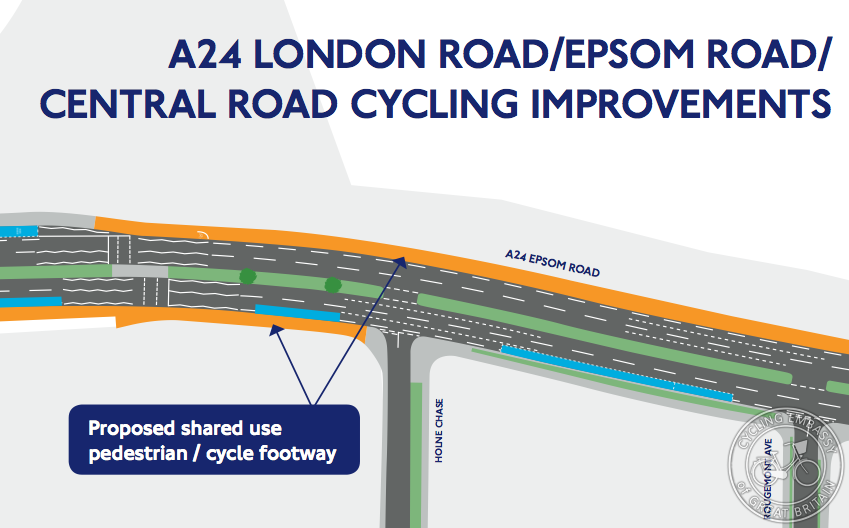Response to the consulation on cycling improvements along the A24 in Morden
We write in response to the consultation on cycling improvements along the A24 Epsom/London Road in Morden, part of Transport for London’s process of junction reviews.

There is very little to recommend in the proposed improvements, which mainly take the form of converting existing pavements to shared use, and turning some existing advisory cycle lanes into mandatory cycle lanes which lack continuity.
The rationale for allowing cycling on the pavement is that it provides a place for the more nervous to cycle. However, there are several sections of this area under consultation where pavement cycling is not permitted at all, and cyclists must return to the carriageway; this makes the conversion of the pavements disjointed, and somewhat pointless.
In addition, having on-carriageway cycle lanes that run alongside wide shared-use pavements represents a poor use of available space. The on-carriageway solution is inadequate, because in several places the lanes will not be sufficiently wide for safe and pleasant cycling. Likewise the off-carriageway solution is inadequate, because it will bring cyclists into needless conflict with pedestrians, particularly more vulnerable groups such as the elderly, children and visually impaired. A better use of the available space would be to construct cycle tracks – dedicated space for cycling, separated from the carriageway – alongside pavements which are clearly for pedestrian use only.
In other locations, the cycle lanes (even those that are to be made mandatory) are still truncated by parking bays. There is clear scope for moving these parking bays out and/or narrowing the pavements slightly, to create cycle tracks/lanes that would run on the inside of the parked cars. This is particularly the case with the proposed (mandatory) cycle lane by Morden Court, which will run directly outside the parking bays, between parked cars and overtaking traffic. A much better solution would be to place the cycle track between the pavement and the parked cars. This would require no extra space, but it would be both safer, because it removes the risk of being hit by the opening doors of parked cars, and would also be more pleasant to use, being separated from the flow of motor vehicles.
We further observe that this section of the A24 is effectively single-carriageway, due to this parking bay, and the bus lane in the opposite direction. There is surely some potential, therefore, for maintaining the A24 as single-carriageway to the south for some distance, and reallocating that carriageway space in the form of protected cycle tracks. These could run behind the bus stops along the A24, freeing buses and cyclists from interaction with each other.
We note the presence of both a primary school and a college along this section of road; encouraging children and students to cycle, by means of safe, dedicated bicycle infrastructure, would serve both to cut congestion and road danger. This should be a priority, even without a reduction in the number of motor vehicle lanes, given the available width of this road, between frontages. Rather than applying a two-tier solution, in the form of on-carriageway cycle lanes alongside shared use pavements, we strongly advise the construction of high-quality separated bicycle infrastructure, suitable for cyclists of all ages and abilities, based on proven examples of success in the Netherlands.
The consultation is open until 9th November. You can leave your own comments on the proposals here. More detail, and photographs, can be found here
